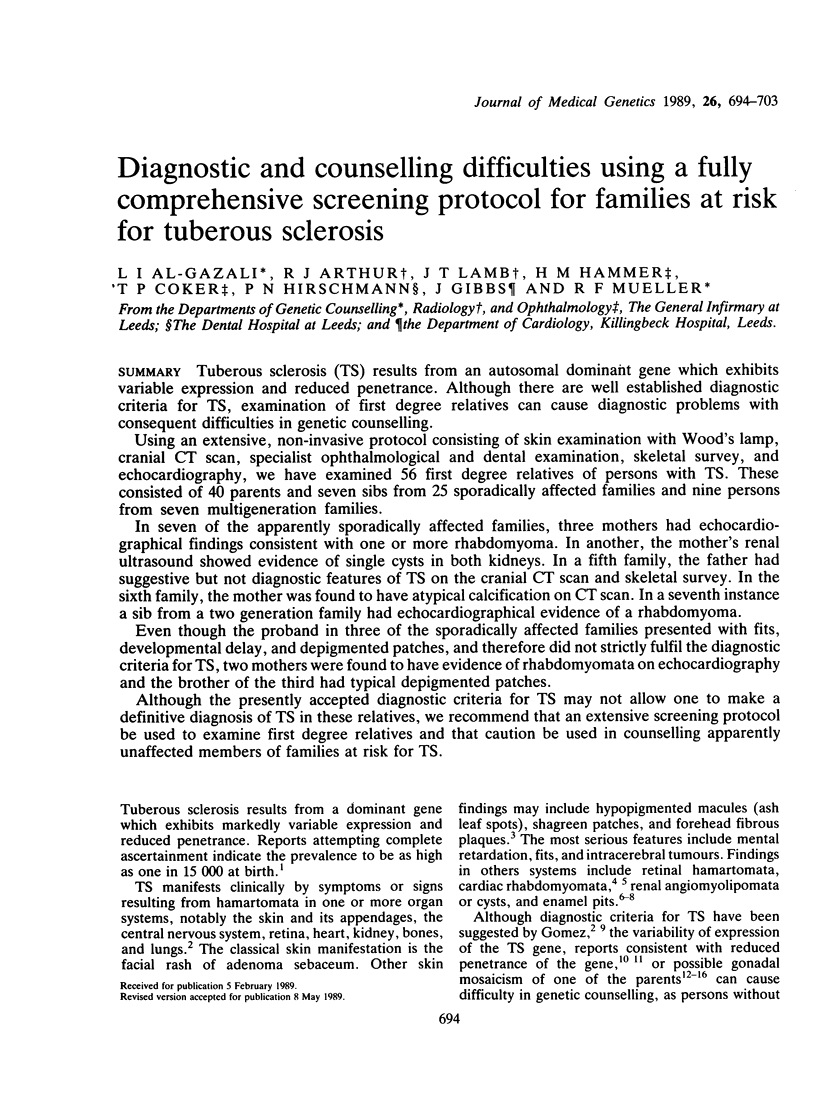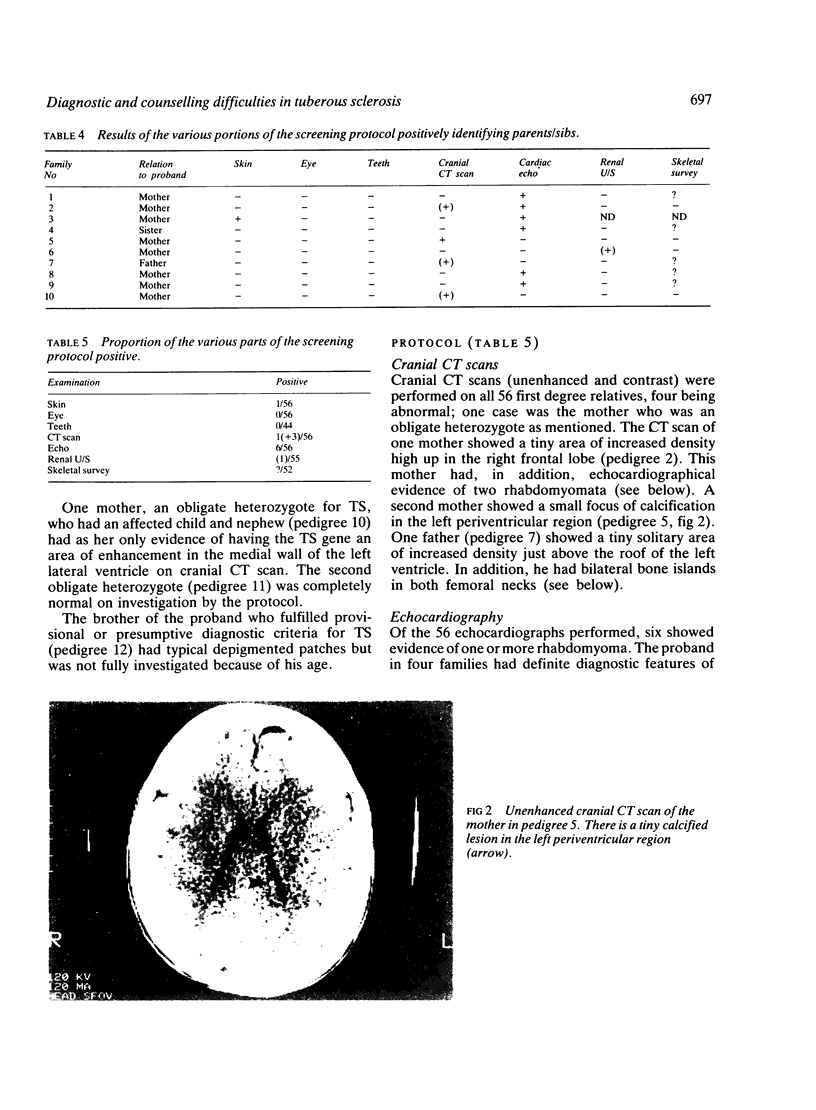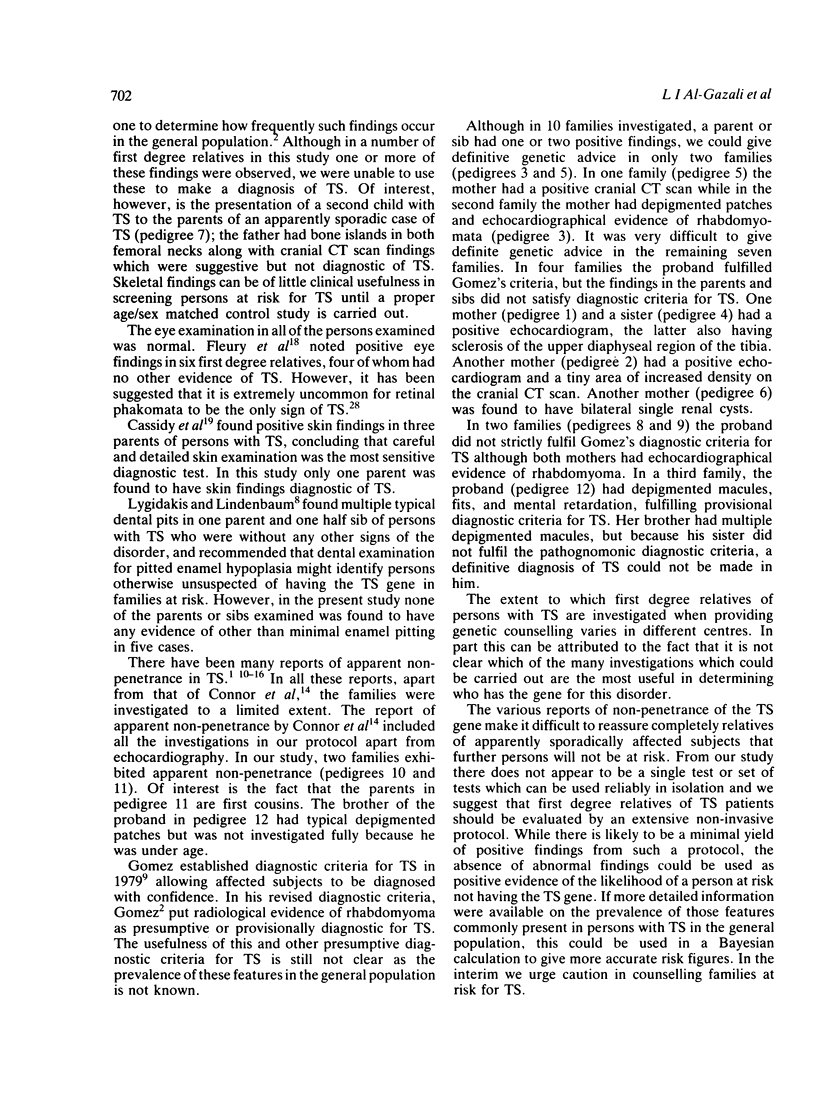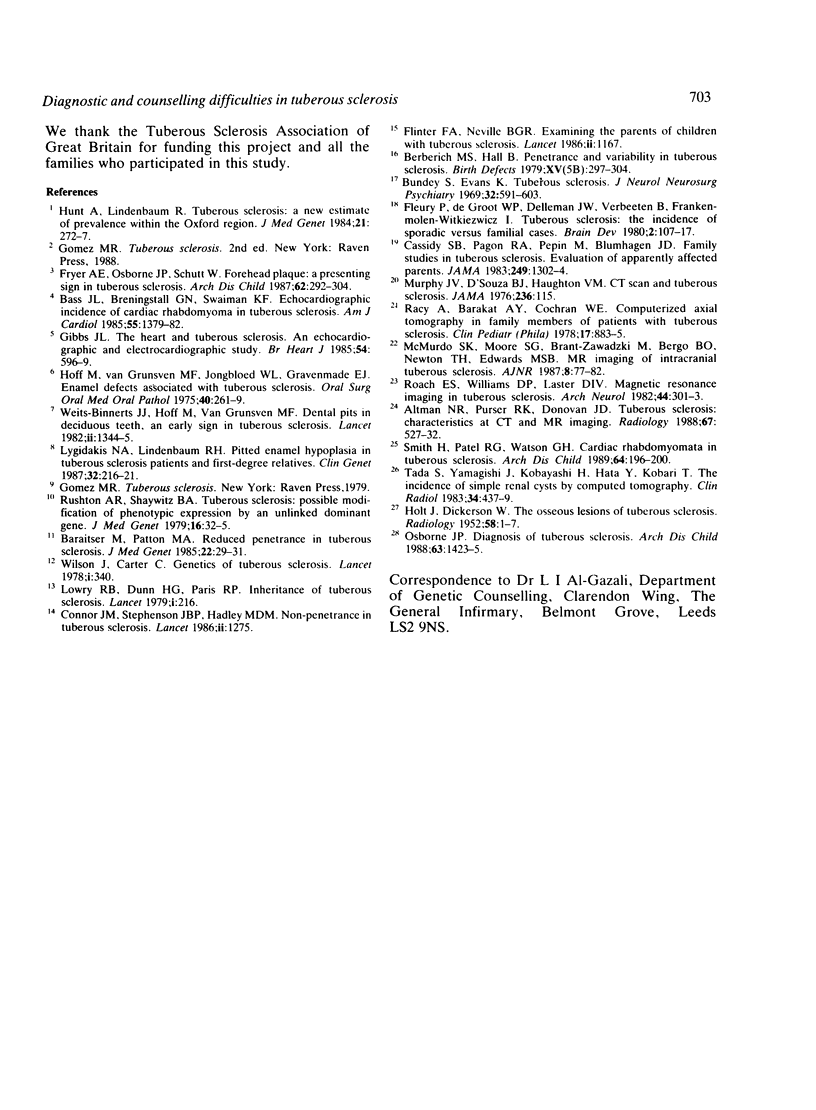Abstract
Tuberous sclerosis (TS) results from an autosomal dominant gene which exhibits variable expression and reduced penetrance. Although there are well established diagnostic criteria for TS, examination of first degree relatives can cause diagnostic criteria for TS, examination of first degree relatives can cause diagnostic problems with consequent difficulties in genetic counselling. Using an extensive, non-invasive protocol consisting of skin examination with Wood's lamp, cranial CT scan, specialist ophthalmological and dental examination, skeletal survey, and echocardiography, we have examined 56 first degree relatives of persons with TS. These consisted of 40 parents and seven sibs from 25 sporadically affected families and nine persons from seven multigeneration families. In seven of the apparently sporadically affected families, three mothers had echocardiographical findings consistent with one or more rhabdomyoma. In another, the mother's renal ultrasound showed evidence of single cysts in both kidneys. In a fifth family, the father had suggestive but not diagnostic features of TS on the cranial CT scan and skeletal survey. In the sixth family, the mother was found to have atypical calcification on CT scan. In a seventh instance a sib from a two generation family had echocardiographical evidence of a rhabdomyoma. Even though the proband in three of the sporadically affected families presented with fits, developmental delay, and depigmented patches, and therefore did not strictly fulfil the diagnostic criteria for TS, two mothers were found to have evidence of rhabdomyomata on echocardiography and the brother of the third had typical depigmented patches. Although the presently accepted diagnostic criteria for TS may not allow one to make a definitive diagnosis of TS in these relatives, we recommend that an extensive screening protocol be used to examine first degree relatives and that caution be used in counselling apparently unaffected members of families at risk for TS.
Full text
PDF









Images in this article
Selected References
These references are in PubMed. This may not be the complete list of references from this article.
- Altman N. R., Purser R. K., Post M. J. Tuberous sclerosis: characteristics at CT and MR imaging. Radiology. 1988 May;167(2):527–532. doi: 10.1148/radiology.167.2.3357966. [DOI] [PubMed] [Google Scholar]
- Baraitser M., Patton M. A. Reduced penetrance in tuberous sclerosis. J Med Genet. 1985 Feb;22(1):29–31. doi: 10.1136/jmg.22.1.29. [DOI] [PMC free article] [PubMed] [Google Scholar]
- Bass J. L., Breningstall G. N., Swaiman K. F. Echocardiographic incidence of cardiac rhabdomyoma in tuberous sclerosis. Am J Cardiol. 1985 May 1;55(11):1379–1382. doi: 10.1016/0002-9149(85)90508-9. [DOI] [PubMed] [Google Scholar]
- Berberich M. S., Hall B. D. Penetrance and variability in tuberous sclerosis. Birth Defects Orig Artic Ser. 1979;15(5B):297–304. [PubMed] [Google Scholar]
- Bundey S., Evans K. Tuberous sclerosis: a genetic study. J Neurol Neurosurg Psychiatry. 1969 Dec;32(6):591–603. doi: 10.1136/jnnp.32.6.591. [DOI] [PMC free article] [PubMed] [Google Scholar]
- Cassidy S. B., Pagon R. A., Pepin M., Blumhagen J. D. Family studies in tuberous sclerosis. evaluation of apparently unaffected parents. JAMA. 1983 Mar 11;249(10):1302–1304. [PubMed] [Google Scholar]
- Connor J. M., Stephenson J. B., Hadley M. D. Non-penetrance in tuberous sclerosis. Lancet. 1986 Nov 29;2(8518):1275–1275. doi: 10.1016/s0140-6736(86)92697-8. [DOI] [PubMed] [Google Scholar]
- Fleury P., de Groot W. P., Delleman J. W., Verbeeten B., Jr, Frankenmolen-Witkiezwicz I. M. Tuberous sclerosis: the incidence of sporadic cases versus familial cases. Brain Dev. 1980;2(2):107–117. doi: 10.1016/s0387-7604(80)80031-3. [DOI] [PubMed] [Google Scholar]
- Flinter F. A., Neville B. G. Examining the parents of children with tuberous sclerosis. Lancet. 1986 Nov 15;2(8516):1167–1167. doi: 10.1016/s0140-6736(86)90581-7. [DOI] [PubMed] [Google Scholar]
- Fryer A. E., Osborne J. P., Schutt W. Forehead plaque: a presenting skin sign in tuberous sclerosis. Arch Dis Child. 1987 Mar;62(3):292–293. doi: 10.1136/adc.62.3.292. [DOI] [PMC free article] [PubMed] [Google Scholar]
- Gibbs J. L. The heart and tuberous sclerosis. An echocardiographic and electrocardiographic study. Br Heart J. 1985 Dec;54(6):596–599. doi: 10.1136/hrt.54.6.596. [DOI] [PMC free article] [PubMed] [Google Scholar]
- HOLT J. F., DICKERSON W. W. The osseous lesions of tuberous sclerosis. Radiology. 1952 Jan;58(1):1–8. doi: 10.1148/58.1.1. [DOI] [PubMed] [Google Scholar]
- Hoff M., van Grunsven M. F., Jongebloed W. L., Gravenmade E. J. Enamel defects associated with tuberous sclerosis. A clinical and scanning-electron-microscope study. Oral Surg Oral Med Oral Pathol. 1975 Aug;40(2):261–269. doi: 10.1016/0030-4220(75)90158-9. [DOI] [PubMed] [Google Scholar]
- Hunt A., Lindenbaum R. H. Tuberous sclerosis: a new estimate of prevalence within the Oxford region. J Med Genet. 1984 Aug;21(4):272–277. doi: 10.1136/jmg.21.4.272. [DOI] [PMC free article] [PubMed] [Google Scholar]
- Lowry R. B., Dunn H. G., Paris R. P. Inheritance of tuberous sclerosis. Lancet. 1979 Jan 27;1(8109):216–216. doi: 10.1016/s0140-6736(79)90618-4. [DOI] [PubMed] [Google Scholar]
- Lygidakis N. A., Lindenbaum R. H. Pitted enamel hypoplasia in tuberous sclerosis patients and first-degree relatives. Clin Genet. 1987 Oct;32(4):216–221. doi: 10.1111/j.1399-0004.1987.tb03304.x. [DOI] [PubMed] [Google Scholar]
- Osborne J. P. Diagnosis of tuberous sclerosis. Arch Dis Child. 1988 Dec;63(12):1423–1425. doi: 10.1136/adc.63.12.1423. [DOI] [PMC free article] [PubMed] [Google Scholar]
- Racy A., Barakat A. Y., Cochran W. E. Computerized axial tomography in family members of patients with tuberous sclerosis. Clin Pediatr (Phila) 1978 Dec;17(12):883–885. doi: 10.1177/000992287801701202. [DOI] [PubMed] [Google Scholar]
- Roach E. S., Williams D. P., Laster D. W. Magnetic resonance imaging in tuberous sclerosis. Arch Neurol. 1987 Mar;44(3):301–303. doi: 10.1001/archneur.1987.00520150047020. [DOI] [PubMed] [Google Scholar]
- Smith H. C., Watson G. H., Patel R. G., Super M. Cardiac rhabdomyomata in tuberous sclerosis: their course and diagnostic value. Arch Dis Child. 1989 Feb;64(2):196–200. doi: 10.1136/adc.64.2.196. [DOI] [PMC free article] [PubMed] [Google Scholar]
- Tada S., Yamagishi J., Kobayashi H., Hata Y., Kobari T. The incidence of simple renal cyst by computed tomography. Clin Radiol. 1983 Jul;34(4):437–439. doi: 10.1016/s0009-9260(83)80238-4. [DOI] [PubMed] [Google Scholar]
- Weits-Binnerts J. J., Hoff M., van Grunsven M. F. Dental pits in deciduous teeth, an early sign in tuberous sclerosis. Lancet. 1982 Dec 11;2(8311):1344–1344. doi: 10.1016/s0140-6736(82)91548-3. [DOI] [PubMed] [Google Scholar]
- Wilson J., Carter C. Genetics of tuberose sclerosis. Lancet. 1978 Feb 11;1(8059):340–340. doi: 10.1016/s0140-6736(78)90125-3. [DOI] [PubMed] [Google Scholar]









